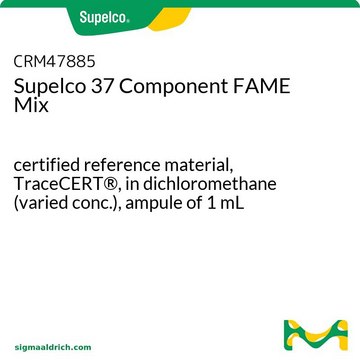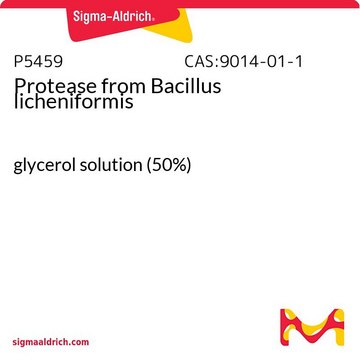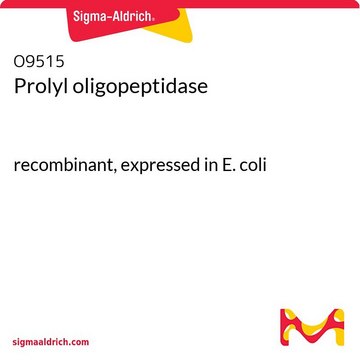T7705
Thimet Oligopeptidase from Bacillus licheniformis
Sign Into View Organizational & Contract Pricing
Select a Size
Change View
20 MG
₩504,658
₩504,658
Please contact Customer Service for Availability
Recommended Products
Related Categories
1 of 4
This Item | P5459 | A3403 | O9515 |
|---|---|---|---|
| Quality Level 200 | Quality Level 200 | Quality Level 200 | Quality Level 200 |
| form powder | form glycerol solution (50%) | form saline solution | form solution |
| storage temp. −20°C | storage temp. 2-8°C | storage temp. 2-8°C | storage temp. −70°C |
| mol wt ~77 kDa | mol wt - | mol wt 57.6 kDa | mol wt 81.6 kDa |
| recombinant expressed in E. coli | recombinant - | recombinant - | recombinant expressed in E. coli |
General description
Thimet oligopeptidase is considered essential in the degradation of collagen in collaboration with collagenolytic enzymes. Thimet oligopeptidase (TOP) is a neuropeptidase involved in the hydrolysis of gonadotropin-releasing hormone, a key component of the hypothalamic-pituitary-gonadal axis. [1]
Application
Thimet oligopeptidase can be used for the degradation of collagen in combination with collagenases. It can also be used for the hydrolysis of neuropeptides such as bradykin, neurotensin, and amyliod-β-peptide. Thimet oligopeptidase has been used in a study to investigate the effect of acute cocaine administration in male rats on TOP specific activity and mRNA levels in prosencephalic brain areas related with the reward circuitry: ventral striatum, hippocampus, and frontal cortex. [2]
Preparation Note
This enzyme has been affinity chromatographically purified using a niquel affinity column. It contains a 6-Histidine tag in its C-terminus.
A working solution of this enzyme can be prepared in 20 mM phosphate buffered saline solution, pH 7.0, or sterile and deionized water, pH 7.0.
A working solution of this enzyme can be prepared in 20 mM phosphate buffered saline solution, pH 7.0, or sterile and deionized water, pH 7.0.
Signal Word
Warning
Hazard Statements
Precautionary Statements
Hazard Classifications
Acute Tox. 4 Inhalation - Skin Irrit. 2
Storage Class Code
11 - Combustible Solids
WGK
WGK 3
Flash Point(F)
Not applicable
Flash Point(C)
Not applicable
Choose from one of the most recent versions:
Certificates of Analysis (COA)
Lot/Batch Number
Don't see the Right Version?
If you require a particular version, you can look up a specific certificate by the Lot or Batch number.
Already Own This Product?
Find documentation for the products that you have recently purchased in the Document Library.
Customers Also Viewed
Kulp K et al.
Batters and Breadings in Food Processing, (2) (2016)
Clare M Reynolds et al.
The Journal of nutritional biochemistry, 24(2), 401-411 (2012-05-26)
Conjugated linoleic acid (CLA) is found naturally in meat and dairy products, and represents a potential therapeutic functional nutrient. However, given the discrepancies in isomer composition and concentration, controversy surrounds its proposed antidiabetic, antiobesity effects. This study focused on the
Eva Katharina Richter et al.
Lipids, 47(2), 161-169 (2011-08-13)
This study explores the potential use of stable carbon isotope ratios (δ(13)C) of single fatty acids (FA) as tracers for the transformation of FA from diet to milk, with focus on the metabolic origin of c9,t11-18:2. For this purpose, dairy
Sanjay Basak et al.
Biochimica et biophysica acta, 1831(4), 834-843 (2013-01-29)
A number of studies have been carried out to examine the biological function of conjugated linoleic acid (CLA) and its potential health benefits. However, not much is known about how CLA isomers mediate their effect on angiogenesis and vascularization during
Jason R Deguire et al.
Nutrition research (New York, N.Y.), 32(12), 911-920 (2012-12-19)
The relationships between conjugated linoleic acid (CLA) status, bone, body composition, and the effect of CLA on calciotropic hormones are unclear. A cross-sectional study was designed to examine the association between c9, t11 CLA status in erythrocyte membranes (RBC) and
Our team of scientists has experience in all areas of research including Life Science, Material Science, Chemical Synthesis, Chromatography, Analytical and many others.
Contact Technical Service











